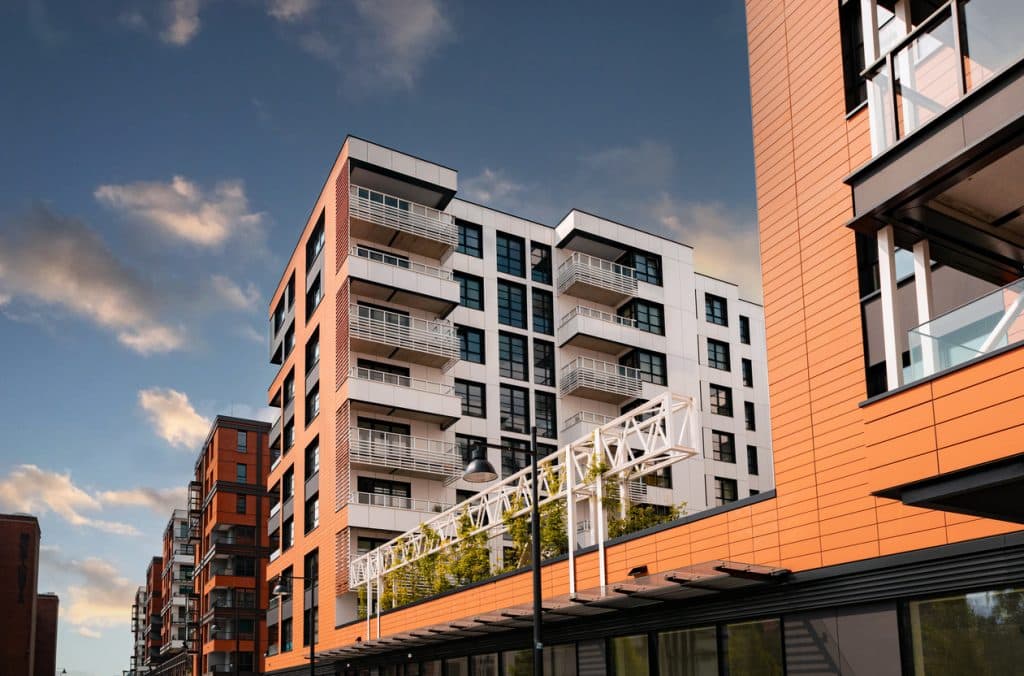
Dealing with the tough rules for higher risk buildings is hard for many developers, landlords, and managing agents. At Payte Architects London, we focus on designing and delivering buildings. We make sure they follow the Building Safety Act 2022 and are monitored by the Building Safety Regulator (BSR).
Our higher risk building consultants has a lot of experience and knows the rules well. We guide you through the whole process. This includes planning, design, registration, and approvals after completion. We take the stress out of compliance and regulatory pressure.
What Is a Higher Risk Building?

A higher risk building is usually a residential structure that:
• is over 18 metres tall
• has at least seven storeys
• includes two or more residential units
This definition, from the Building Safety Act, puts stricter safety and compliance rules on these buildings. This is because they are complex and could pose risks to residents.
In some cases, other building types—such as those with vulnerable occupants—may also fall within this category. Our higher risk building consultants will help you find out if your project is a higher risk building under the new rules. We’ll also explain how this affects your obligations.
Understanding the Higher Risk Building Definition
The definition of a higher risk building isn’t fixed. It changes with new laws and how the BSR interprets them. Understanding whether your development qualifies is the first step toward compliance.
Misunderstanding the definition can result in serious legal and financial issues. This is especially true if a building isn’t registered or doesn’t meet gateway requirements.
We keep up with all updates on higher risk building regulations, including the latest from 2023 and beyond. We also advise clients on how these definitions apply to their projects at every development stage.
The Building Safety Act and the BSR (Building Safety Regulator)
The Building Safety Act 2022 is the UK’s most significant reform of building safety legislation in decades. The Act focuses on creating the Building Safety Regulator (BSR). The BSR ensures compliance and enforces new standards for higher-risk buildings.
Key responsibilities under the Act include:
• Complying with Gateway 1: Early planning submissions that address fire safety
• Submitting complete design details for Gateway 2 before construction begins
• Gaining approval for occupation under Gateway 3, including safety case documentation
Each stage needs formal approval from the BSR for all required submissions. Our team fully owns these deliverables. This way, your project moves forward without regulatory delays.
Navigating the Higher Risk Building Register
If your building is “higher risk,” it must go on the higher risk building register. The BSR manages this register. This is a key legal requirement before occupation. It should clearly explain how the building is used, its layout, safety features, and compliance history.
• We manage this process from end to end, including:
• Eligibility checks against current legislation
• Preparation of the required documentation and evidence
• Submission to the register of higher risk buildings
• Liaising with the BSR to address any queries or clarification requests
Many London architect firms shy away from legislation around higher risk buildings, clients rely on us to remove the burden of complex submissions and ensure that their buildings are registered correctly and on time. As a principal designer we are fully competent and well positioned to work on these projects. Visit our page on the role of a principal designer to understand why this is such as important element when dealing with BSR.
Processes Our Higher Risk Building Consultants handle for clients
At Payte Architects London, we don’t just design buildings. We also manage important processes to make sure your project is legally and operationally successful.
Our services include:
• Definition Review: Check if your site or project meets the criteria for higher risk buildings
• Full Registration: Gather and send all required documents for the higher risk building register
• Gateway Management: Preparing documentation and designs for all three regulatory stages
• Safety Case Preparation: Coordinating structural and fire safety reporting as required by the BSR
• Accountable Person Support: Advising clients on their roles and responsibilities under the Act
• Upgrading Existing Buildings: Overseeing improvements to higher-risk buildings, like refurbishments and safety upgrades
Every step is done carefully. This keeps your project compliant, helps you avoid costly penalties, and ensures it stays on schedule.
Avoiding the Risks of Non-Compliance
Ignoring the Building Safety Act and its rules can lead to serious consequences. Not registering a building, missing gateway approvals, or submitting incomplete safety documents can lead to:
• Legal action or fines
• Enforcement notices
• Stop-work orders
• Delays to project delivery
• Loss of insurance or funding
• Reputational damage
Our role is to eliminate those risks by handling the regulatory process for you—from initial brief to final sign-off by the BSR.
Lessons We’ve Learned About British Safety Regulations And Higher Risk Buildings
Understanding and complying with British Safety Regulations is essential for any project involving higher-risk buildings. For example, navigating a Licence to Alter for a retail Higher-Risk Building requires careful planning and coordination with landlords and solicitors.
Equally, ensuring safety in design means recognising the importance of structural engineers in British Safety Regulation applications, where their expertise plays a critical role in meeting compliance standards and protecting occupants.
Why Choose Payte Architects London for Higher Risk Buildings?
It’s important to choose an architectural partner who knows design and regulations. At Payte Architects London, we blend beauty with legal accuracy. This helps clients create buildings that are stunning and meet all regulations.
What sets us apart:
• Proven experience across a variety of higher risk building projects
• Detailed knowledge of Building Safety Act requirements and updates
• In-house ability to manage Gateway submissions and BSR communications
• Ongoing training and compliance audits to stay ahead of regulatory changes
• Transparent project management and client communication
We help developers, housing associations, institutional landlords, and asset managers. We guide them through a fast-changing legal landscape. They can keep moving forward without losing design quality.
Working With Existing Higher-Risk Buildings
The Building Safety Act covers both new developments and existing high-risk buildings. These structures must often undergo retrofitting, documentation updates, or formal registration.
We assist with:
• Fire compartmentation improvements
• Façade and cladding replacements
• Access and egress enhancements
• Safety case updates for occupied buildings
• Onboarding and compliance for Accountable Persons
If you manage a property that might qualify as a higher risk building, we can assess your situation. Then, we’ll create a plan for compliance and long-term safety.
